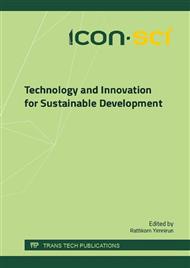[1]
C. Ageorges, L. Ye, and M. Hou, Advances in fusion bonding techniques for joining thermoplastic matrix composites: a review. Compos Part A Appl Sci Manuf, 32 (2001) 839-857.
DOI: 10.1016/s1359-835x(00)00166-4
Google Scholar
[2]
T. Zoubeir and G. Elhem, Numerical study of laser diode transmission welding of a PP mini-tank: Temperature field and residual stresses distribution. Polymer Testing, 30 (2011) 23-34.
DOI: 10.1016/j.polymertesting.2010.10.008
Google Scholar
[3]
O. Balkan, H. Demirer, A. Ezdeşir and H. Yıldırım, Effects of welding procedures on mechanical and morphological properties of hot gas butt welded PE, PP, and PVC sheets. Poly. Eng. Sci., 48 (2008) 732–746.
DOI: 10.1002/pen.21014
Google Scholar
[4]
N. Amanat, N.L. James, and D.R. McKenzie, Welding methods for joining thermoplastic polymers for the hermetic enclosure of medical devices, Med Eng Phys., 32 (2010) 690-699.
DOI: 10.1016/j.medengphy.2010.04.011
Google Scholar
[5]
X Wang, H. Chen and H. Liu, Investigation of the relationships of process parameters, molten pool geometry and shear strength in laser transmission welding of polyethylene terephthalate and PP. Mater Des, 2014. 55 (2014) 343-352.
DOI: 10.1016/j.matdes.2013.09.052
Google Scholar
[6]
O. Balkan, H. Demirer and H. Yildirim, Morphological and mechanical properties of hot gas welded PE, PP and PVC sheets. J. Achiev. Mater. Manuf. Eng., 31 (2008) 60 - 70.
DOI: 10.1002/pen.21014
Google Scholar
[7]
H. Pelletier, C. Gauthier, and R. Schirrer, Relationship between contact geometry and average plastic strain during scratch tests on amorphous polymers. Tribo. Inter., 43 (2010) 796-809.
DOI: 10.1016/j.triboint.2009.11.006
Google Scholar
[8]
H. Pelletier, J. Krier, and C. Gauthier, Influence of local friction coefficient and strain hardening on the scratch resistance of polymeric surfaces investigated by finite element modeling. Proc. Eng., 10 (2011) 1772-1778.
DOI: 10.1016/j.proeng.2011.04.295
Google Scholar
[9]
H. Jiang, R. Browning and H.J. Sue, Understanding of scratch-induced damage mechanisms in polymers, Polymer, 50 (2009) 4056-4065.
DOI: 10.1016/j.polymer.2009.06.061
Google Scholar


